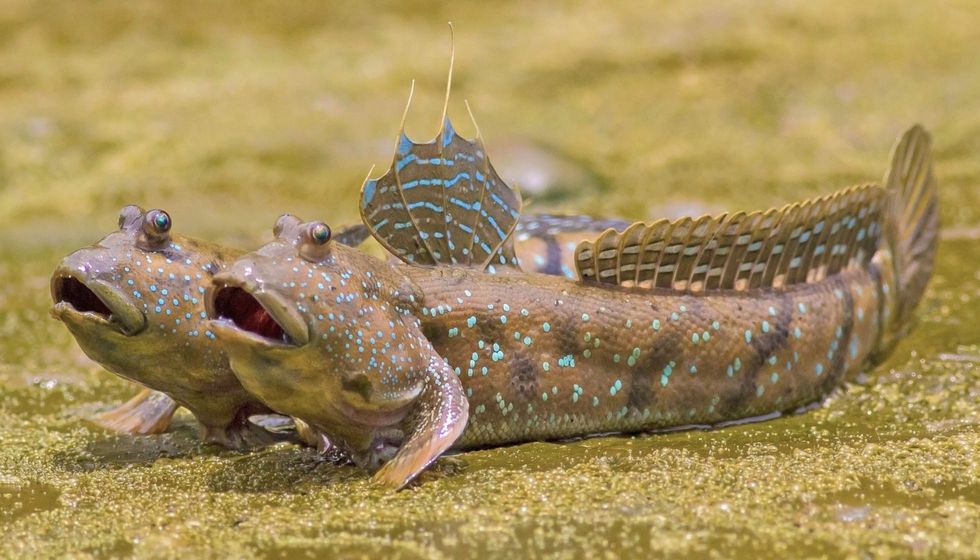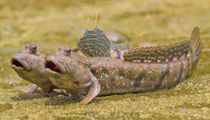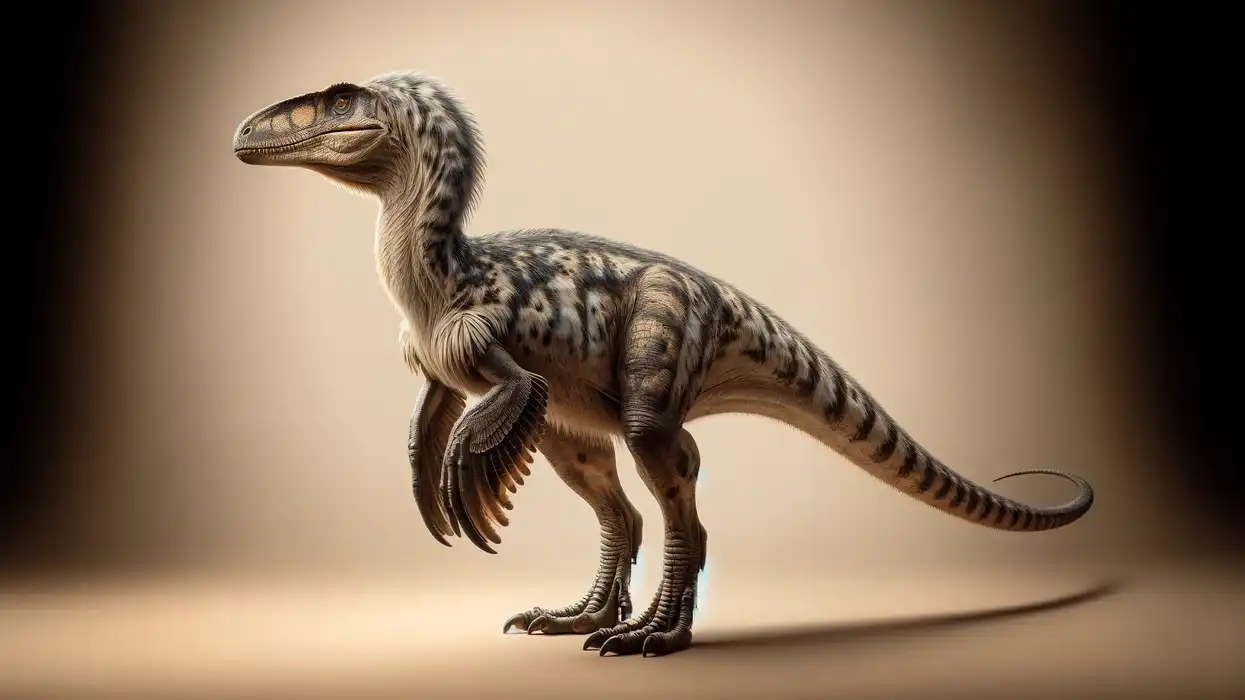The giant mudskipper (P. schlosseri) is a fish that belongs to the genus Periophthalmodon and the family Oxudercidae. The giant mudskipper size is the largest of all the mudskipper fishes. This fish species is euryhaline in nature, which means it can tolerate various levels of salinity in the water where it resides.
This fish also has several adaptive features that help it survive both on water and on land. The fish can move on land using its pectoral fins, which help it to hop around.
The pelvic fins of the fish are useful for moving up roots or rocks, and the pectoral fins assist in pulling or pushing the fish high or low.
Giant mudskippers have a unique type of gill, which is supported by thick gill rods. This helps the gills act as a respiratory organ on land as well.
The skin and buccal cavity of the fish is also full of blood capillaries which that in turn support respiration. This is why giant mudskippers keep rolling their body around on muddy shores to absorb gaseous oxygen directly. Keep reading for more interesting facts about the giant mudskipper!
If you liked this article about giant mudskipper facts, also check out other articles with amazing facts about the warty frogfish and pigfish!
Giant Mudskipper Interesting Facts
What type of animal is a giant mudskipper?
The giant mudskipper (Periophthalmodon schlosseri) is a type of fish.
What class of animal does a giant mudskipper belong to?
The giant mudskipper (Periophthalmodon schlosseri) belongs to the Actinopterygii class of animals and the family of Oxudercidae.
How many giant mudskippers are there in the world?
The exact population of giant mudskippers in the world has not yet been calculated by researchers and scientists yet.
Where does a giant mudskipper live?
Giant mudskippers are found in the waters of the eastern Indian Ocean and the western Pacific Ocean. They are found primarily in Southeast Asia, including the countries of Vietnam, Singapore, Thailand, Malaysia, and parts of Indonesia.
What is a giant mudskipper's habitat?
The giant mudskipper's ideal habitat is that of the marine coasts and freshwater areas near the oceans. In addition to that, it is also found in the muddy shores near rivers and estuaries.
In high tidal zones, it is found in burrows in the mangrove habitat regions or the mudflats in those areas. During high tides in those tidal zones, they may be seen to cling to a mangrove tree or its roots to save their life. During low tide, they comfortably swim around in large pools of water.
Who do giant mudskippers live with?
Not much is known about the social behavior of giant mudskippers. However, it is worth noting that the fish has spent so much time out of water that it has deftly adapted itself to the land, and it almost acts as an amphibious animal now.
How long does a giant mudskipper live?
Scientists have not yet been able to observe the exact lifespan of giant mudskippers. However, most mudskippers have an average lifespan of five years in the wild.
How do they reproduce?
The reproduction cycle of this species is noted to start from June and extend till October. During the breeding season, males become more active, and their colors become brighter. The nesting site for laying the eggs is usually a burrow which is made by the fishes removing mud from the surface.
Once the burrow is made, males exhibit a courtship ritual by leaping in the air or flipping their fins. They are also noted to be aggressive to other males and might start biting them.
Once the fertilized eggs turn into embryos, a hatching gland helps hatch the eggs. The larvae remain in the burrow till they mature into young fishes.
What is their conservation status?
According to the International Union for Conservation of Nature (IUCN), the giant mudskipper has been listed under the category of Least Concern.
Giant Mudskipper Fun Facts
What do giant mudskippers look like?
The giant mudskipper has a dull yellow-brown colored body. There is a black stripe on each of its flanks from its eye to the tail. Some fishes may also have a dark stripe on the back.
Their cheeks have bluish-white spots, and their dorsal fin is red or brown in color. The rear dorsal fin of the fish is dark in color along with a pale, white margin.
How cute are they?
Giant mudskippers are not cute at all! These fishes spend all their time in muddy waters and have an unappealing yellow-ish-colored body. In comparison, the Arowana fish found in the same geographical range is much better to look at.
How do they communicate?
The mudskipper species mostly communicate using sound in their burrows along with their body language. Some males can get quite territorial about their mud burrow and might even get aggressive with other fishes.
How big is a giant Mudskipper?
The length of the giant mudskipper usually falls between the range of 5.9-10.6 in (15-27 cm).
The catfish is almost five to six times the length of the giant mudskipper because it grows up to 25–60 in (63.5–152.4 cm) in length.
How fast can a giant mudskipper swim?
Not much is known about the speed of a giant mudskipper as it swims in its marine habitat. However, they are not known to be good swimmers.
How much does a giant mudskipper weigh?
Although the length of giant mudskippers has been observed, scientists have not yet observed the range of weight of this species.
What are the male and female names of the species?
There are no unique names for males and females of this species. Consequently, they are usually referred to as male or female giant mudskipper.
What would you call a baby giant mudskipper?
There is no separate, distinct name to refer to a baby giant mudskipper. The eggs hatch into larvae and mature into young or juvenile giant mudskippers.
What do they eat?
This species is carnivorous in nature. Its diet primarily consists of fiddler crabs, medaka fish, and other types of juvenile fish. They can leave their low mud burrows and go up to 4200 sq ft (390.1 sq m) in order to look for crabs and fish.
Are they dangerous?
Giant mudskippers are not known for being dangerous to human beings. Rather, this species is preyed upon by herons, kingfishers, and dog-faced watersnakes.
Would they make a good pet?
While giant mudskippers are not the most common mudskipper species to be kept as a pet, some people also prefer to keep this species as a pet. As they are mostly used to salty water on the land full of mangrove trees, a giant mudskipper pet is quite demanding, unlike the guppy fish.
They require a tropical beachy surface in the aquarium along with shallow water to replicate the kind of tropical surface they usually live in on the ocean shores filled with mud.
Did you know...
Apart from their natural predators in the wild, giant mudskippers are also hunted by humans. This is because many humans believe that these fishes have medicinal properties that can be used for healing.
Is the giant mudskipper native to Singapore?
The giant mudskipper species is not native or endemic to Singapore. This fish can be found throughout the Southeast Asian region, including countries like Thailand, Malaysia, Vietnam, and parts of Indochina, along with Singapore.
What is the largest mudskipper?
The largest mudskipper on earth is the giant mudskipper. This fish species can be found in the fresh-water environments and the shores of the Pacific Ocean and the Indian Ocean. It is found in areas of high tide or low tide in Thailand, Malaysia, Vietnam, and parts of Indochina along with Singapore.
Here at Kidadl, we have carefully created lots of interesting family-friendly animal facts for everyone to discover! For more relatable content, check out these Sperata facts and Hampala Barb facts pages.
You can even occupy yourself at home by coloring in one of our free printable mudskipper coloring pages.









